Critical versus prompt-critical
In a supercritical assembly, the number of fissions per unit time, N, along with the power production, increases exponentially with time. How fast it grows depends on the average time it takes, T, for the neutrons released in a fission event to cause another fission. The growth rate of the reaction is given by:

Most of the neutrons released by a fission event are the ones released in the fission itself. These are called prompt neutrons, and strike other nuclei and cause additional fissions within nanoseconds (an average time interval used by scientists in the Manhattan Project was one shake, or 10 ns). A small additional source of neutrons is the fission products. Some of the nuclei resulting from the fission are radioactive isotopes with short half-lives, and nuclear reactions among them release additional neutrons after a long delay of up to several minutes after the initial fission event. These neutrons, which on average account for less than one percent of the total neutrons released by fission, are called delayed neutrons. The relatively slow timescale on which delayed neutrons appear is an important aspect for the design of nuclear reactors, as it allows the reactor power level to be controlled via the gradual, mechanical movement of control rods. Typically, control rods contain neutron poisons (substances, for example boron or hafnium, that easily capture neutrons without producing any additional ones) as a means of altering k-effective. With the exception of experimental pulsed reactors, nuclear reactors are designed to operate in a delayed-critical mode and are provided with safety systems to prevent them from ever achieving prompt criticality.
In a delayed-critical assembly, the delayed neutrons are needed to make k-effective greater than one. Thus the time between successive generations of the reaction, T, is dominated by the time it takes for the delayed neutrons to be released, of the order of seconds or minutes. Therefore, the reaction will increase slowly, with a long time constant. This is slow enough to allow the reaction to be controlled with electromechanical control systems such as control rods, and accordingly all nuclear reactors are designed to operate in the delayed-criticality regime.
In contrast, a critical assembly is said to be prompt-critical if it is critical (k = 1) without any contribution from delayed neutrons and prompt-supercritical if it is supercritical (the fission rate growing exponentially, k > 1) without any contribution from delayed neutrons. In this case the time between successive generations of the reaction, T, is limited only by the fission rate from the prompt neutrons, and the increase in the reaction will be extremely rapid, causing a rapid release of energy within a few milliseconds. Prompt-critical assemblies are created by design in nuclear weapons and some specially designed research experiments.
The difference between a prompt neutron and a delayed neutron has to do with the source from which the neutron has been released into the reactor. The neutrons, once released, have no difference except the energy or speed that have been imparted to them. A nuclear weapon relies heavily on prompt-supercriticality (to produce a high peak power in a fraction of a second), whereas nuclear power reactors use delayed-criticality to produce controllable power levels for months or years.
Nuclear reactors
In order to start up a controllable fission reaction, the assembly must be delayed-critical. In other words, k must be greater than 1 (supercritical) without crossing the prompt-critical threshold. In nuclear reactors this is possible due to delayed neutrons. Because it takes some time before these neutrons are emitted following a fission event, it is possible to control the nuclear reaction using control rods.
A steady-state (constant power) reactor is operated so that it is critical due to the delayed neutrons, but would not be so without their contribution. During a gradual and deliberate increase in reactor power level, the reactor is delayed-supercritical. The exponential increase of reactor activity is slow enough to make it possible to control the criticality factor, k, by inserting or withdrawing rods of neutron absorbing material. Using careful control rod movements, it is thus possible to achieve a supercritical reactor core without reaching an unsafe prompt-critical state.
Once a reactor plant is operating at its target or design power level, it can be operated to maintain its critical condition for long periods of time.
Prompt critical accidents
Nuclear reactors can be susceptible to prompt-criticality accidents if a large increase in reactivity (or k-effective) occurs, e.g., following failure of their control and safety systems. The rapid uncontrollable increase in reactor power in prompt-critical conditions is likely to irreparably damage the reactor and in extreme cases, may breach the containment of the reactor. Nuclear reactors' safety systems are designed to prevent prompt criticality and, for defense in depth, reactor structures also provide multiple layers of containment as a precaution against any accidental releases of radioactive fission products.
With the exception of research and experimental reactors, only a small number of reactor accidents are thought to have achieved prompt criticality, for example Chernobyl #4, the U.S. Army's SL-1, and Soviet submarine K-431. In all these examples the uncontrolled surge in power was sufficient to cause an explosion that destroyed each reactor and released radioactive fission products into the atmosphere.
At Chernobyl in 1986, a poorly understood positive scram effect resulted in an overheated reactor core. This led to the rupturing of the fuel elements and water pipes, vaporization of water, a steam explosion, and a meltdown. Estimated power levels prior to the incident suggest that it operated in excess of 30 GW, ten times its 3 GW maximum thermal output. The reactor chamber's 2000-ton lid was lifted by the steam explosion. Since the reactor was not designed with a containment building capable of containing this catastrophic explosion, the accident released large amounts of radioactive material into the environment.
In the other two incidents, the reactor plants failed due to errors during a maintenance shutdown that was caused by the rapid and uncontrolled removal of at least one control rod. The SL-1 was a prototype reactor intended for use by the US Army in remote polar locations. At the SL-1 plant in 1961, the reactor was brought from shutdown to prompt critical state by manually extracting the central control rod too far. As the water in the core quickly converted to steam and expanded (in just a few milliseconds), the 26,000-pound (12,000 kg) reactor vessel jumped 9 feet 1 inch (2.77 m), leaving impressions in the ceiling above. [1] [2] All three men performing the maintenance procedure died from injuries. 1,100 curies of fission products were released as parts of the core were expelled. It took 2 years to investigate the accident and clean up the site. The excess prompt reactivity of the SL-1 core was calculated in a 1962 report: [3]
The delayed neutron fraction of the SL-1 is 0.70%... Conclusive evidence revealed that the SL-1 excursion was caused by the partial withdrawal of the central control rod. The reactivity associated with the 20-inch withdrawal of this one rod has been estimated to be 2.4% δk/k, which was sufficient to induce prompt criticality and place the reactor on a 4 millisecond period.
In the K-431 reactor accident, 10 were killed during a refueling operation. The K-431 explosion destroyed the adjacent machinery rooms and ruptured the submarine's hull. In these two catastrophes, the reactor plants went from complete shutdown to extremely high power levels in a fraction of a second, damaging the reactor plants beyond repair.

Nuclear fission is a reaction in which the nucleus of an atom splits into two or more smaller nuclei. The fission process often produces gamma photons, and releases a very large amount of energy even by the energetic standards of radioactive decay.

In nuclear physics, a nuclear chain reaction occurs when one single nuclear reaction causes an average of one or more subsequent nuclear reactions, thus leading to the possibility of a self-propagating series or "positive feedback loop" of these reactions. The specific nuclear reaction may be the fission of heavy isotopes. A nuclear chain reaction releases several million times more energy per reaction than any chemical reaction.

A nuclear reactor is a device used to initiate and control a fission nuclear chain reaction or nuclear fusion reactions. Nuclear reactors are used at nuclear power plants for electricity generation and in nuclear marine propulsion. Heat from nuclear fission is passed to a working fluid, which in turn runs through steam turbines. These either drive a ship's propellers or turn electrical generators' shafts. Nuclear generated steam in principle can be used for industrial process heat or for district heating. Some reactors are used to produce isotopes for medical and industrial use, or for production of weapons-grade plutonium. As of 2022, the International Atomic Energy Agency reports there are 422 nuclear power reactors and 223 nuclear research reactors in operation around the world.

A pressurized water reactor (PWR) is a type of light-water nuclear reactor. PWRs constitute the large majority of the world's nuclear power plants. In a PWR, the primary coolant (water) is pumped under high pressure to the reactor core where it is heated by the energy released by the fission of atoms. The heated, high pressure water then flows to a steam generator, where it transfers its thermal energy to lower pressure water of a secondary system where steam is generated. The steam then drives turbines, which spin an electric generator. In contrast to a boiling water reactor (BWR), pressure in the primary coolant loop prevents the water from boiling within the reactor. All light-water reactors use ordinary water as both coolant and neutron moderator. Most use anywhere from two to four vertically mounted steam generators; VVER reactors use horizontal steam generators.

A nuclear meltdown is a severe nuclear reactor accident that results in core damage from overheating. The term nuclear meltdown is not officially defined by the International Atomic Energy Agency or by the United States Nuclear Regulatory Commission. It has been defined to mean the accidental melting of the core of a nuclear reactor, however, and is in common usage a reference to the core's either complete or partial collapse.
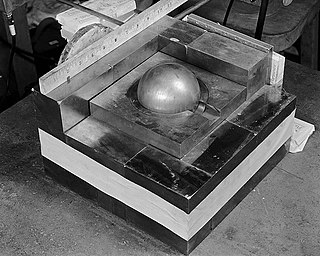
In nuclear engineering, a critical mass is the smallest amount of fissile material needed for a sustained nuclear chain reaction. The critical mass of a fissionable material depends upon its nuclear properties, density, shape, enrichment, purity, temperature, and surroundings. The concept is important in nuclear weapon design.
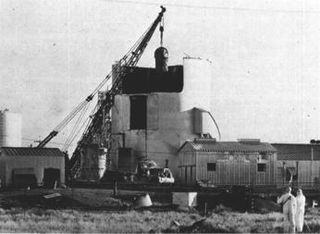
Stationary Low-Power Reactor Number One, also known as SL-1 or the Argonne Low Power Reactor (ALPR), was a United States Army experimental nuclear reactor in the western United States at the National Reactor Testing Station (NRTS) in Idaho about forty miles (65 km) west of Idaho Falls, now the Idaho National Laboratory. On January 3, 1961, at 9:01 pm MST, an operator fully pulled out the reactor’s central control rod, causing the reactor to go prompt critical. The intense heat generated an extreme water hammer which propelled the reactor vessel to the roof of the reactor building. The operator standing on top of the reactor lid was pinned to the roof of the reactor building with expelled control rod shield plugs, while the reactor expelled water, debris, and fuel. The release of materials hit two other operators, killing them. The reactor vessel then fell down to its original position. Press reported a steam explosion killed all three of its young military operators, pinning one of them to the ceiling with a reactor vessel plug. It remains the only U.S. reactor accident to cause immediate deaths.

A scram or SCRAM is an emergency shutdown of a nuclear reactor effected by immediately terminating the fission reaction. It is also the name that is given to the manually operated kill switch that initiates the shutdown. In commercial reactor operations, this type of shutdown is often referred to as a "scram" at boiling water reactors (BWR), a "reactor trip" at pressurized water reactors and EPIS at a CANDU reactor. In many cases, a scram is part of the routine shutdown procedure, which serves to test the emergency shutdown system.
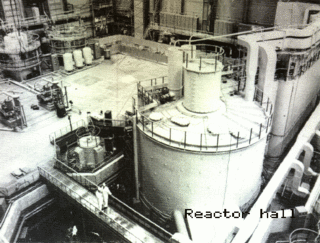
A fast-neutron reactor (FNR) or fast-spectrum reactor or simply a fast reactor is a category of nuclear reactor in which the fission chain reaction is sustained by fast neutrons, as opposed to slow thermal neutrons used in thermal-neutron reactors. Such a fast reactor needs no neutron moderator, but requires fuel that is relatively rich in fissile material when compared to that required for a thermal-neutron reactor. Around 20 land based fast reactors have been built, accumulating over 400 reactor years of operation globally. The largest of this was the Superphénix Sodium cooled fast reactor in France that was designed to deliver 1,242 MWe. Fast reactors have been intensely studied since the 1950s, as they provide certain advantages over the existing fleet of water cooled and water moderated reactors. These are:
A criticality accident is an accidental uncontrolled nuclear fission chain reaction. It is sometimes referred to as a critical excursion, critical power excursion, or divergent chain reaction. Any such event involves the unintended accumulation or arrangement of a critical mass of fissile material, for example enriched uranium or plutonium. Criticality accidents can release potentially fatal radiation doses if they occur in an unprotected environment.

The light-water reactor (LWR) is a type of thermal-neutron reactor that uses normal water, as opposed to heavy water, as both its coolant and neutron moderator; furthermore a solid form of fissile elements is used as fuel. Thermal-neutron reactors are the most common type of nuclear reactor, and light-water reactors are the most common type of thermal-neutron reactor.
A subcritical reactor is a nuclear fission reactor concept that produces fission without achieving criticality. Instead of sustaining a chain reaction, a subcritical reactor uses additional neutrons from an outside source. There are two general classes of such devices. One uses neutrons provided by a nuclear fusion machine, a concept known as a fusion–fission hybrid. The other uses neutrons created through spallation of heavy nuclei by charged particles such as protons accelerated by a particle accelerator, a concept known as an accelerator-driven system (ADS) or accelerator-driven sub-critical reactor.
In nuclear engineering, a prompt neutron is a neutron immediately emitted by a nuclear fission event, as opposed to a delayed neutron decay which can occur within the same context, emitted after beta decay of one of the fission products anytime from a few milliseconds to a few minutes later.
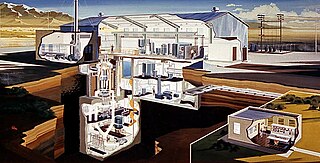
The BORAX Experiments were a series of safety experiments on boiling water nuclear reactors conducted by Argonne National Laboratory in the 1950s and 1960s at the National Reactor Testing Station in eastern Idaho. They were performed using the five BORAX reactors that were designed and built by Argonne. BORAX-III was the first nuclear reactor to supply electrical power to the grid in the United States in 1955.
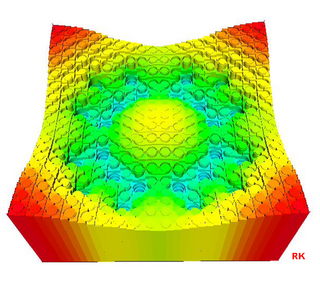
Nuclear reactor physics is the field of physics that studies and deals with the applied study and engineering applications of chain reaction to induce a controlled rate of fission in a nuclear reactor for the production of energy. Most nuclear reactors use a chain reaction to induce a controlled rate of nuclear fission in fissile material, releasing both energy and free neutrons. A reactor consists of an assembly of nuclear fuel, usually surrounded by a neutron moderator such as regular water, heavy water, graphite, or zirconium hydride, and fitted with mechanisms such as control rods which control the rate of the reaction.
The Clean and Environmentally Safe Advanced Reactor (CAESAR) is a nuclear reactor concept created by Claudio Filippone, the Director of the Center for Advanced Energy Concepts at the University of Maryland, College Park and head of the ongoing CAESAR Project. The concept's key element is the use of steam as a moderator, making it a type of reduced moderation water reactor. Because the density of steam may be controlled very precisely, Filippone claims it can be used to fine-tune neutron fluxes to ensure that neutrons are moving with an optimal energy profile to split 238
92U
nuclei – in other words, cause fission.

The demon core was a sphere of plutonium that was involved in two fatal radiation accidents when scientists tested it as a fissile core of an early atomic bomb. It was manufactured by the Manhattan Project, the U.S. nuclear weapon development effort during World War II. It was a subcritical mass that weighed 6.2 kilograms (14 lb) and was 8.9 centimeters (3.5 in) in diameter.
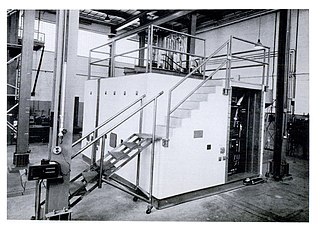
Clementine was the code name for the world's first fast-neutron reactor, also known as the Los Alamos fast plutonium reactor. It was an experimental-scale reactor. The maximum output was 25 kW and was fueled by plutonium and cooled by liquid mercury. Clementine was located at Los Alamos National Laboratory in Los Alamos, New Mexico. Clementine was designed and built in 1945–1946 and first achieved criticality in 1946 and full power in March 1949. The reactor was named after the song "Oh My Darling, Clementine." The similarities to the song were that the reactor was located in a deep canyon and the reactor operators were 49'ers, as 49 was one of the code names for plutonium at the time.

The hydrogen-moderated self-regulating nuclear power module (HPM), also referred to as the compact self-regulating transportable reactor (ComStar), is a type of nuclear power reactor using hydride as a neutron moderator. The design is inherently safe, as the fuel and the neutron moderator is uranium hydride UH3, which is reduced at high temperatures (500–800 °C) to uranium and hydrogen. The gaseous hydrogen exits the core, being absorbed by hydrogen absorbing material such as depleted uranium, thus making it less critical. This means that with rising temperature the neutron moderation drops and the nuclear fission reaction in the core is dampened, leading to a lower core temperature. This means as more energy is taken out of the core the moderation rises and the fission process is stoked to produce more heat.
A dollar is a unit of reactivity for a nuclear reactor, calibrated to the interval between the conditions of criticality and prompt criticality. Prompt criticality will result in an extremely rapid power rise, with the resultant destruction of the reactor, unless it is specifically designed to tolerate the condition. A cent is 1⁄100 of a dollar.














